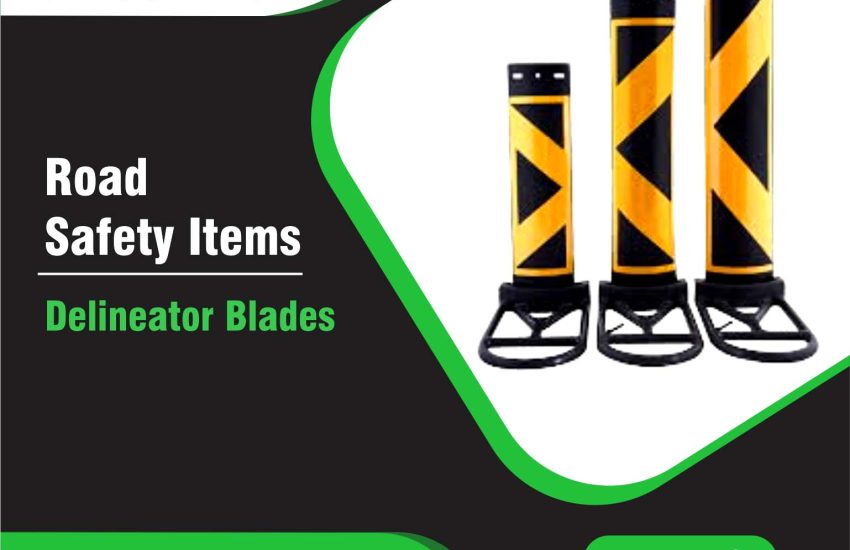Delineator Blades are essential traffic control devices that help manage vehicle and pedestrian movement on roads, highways, and construction zones. These durable, highly visible blades guide traffic, reduce accidents, and improve safety. In this article, we will explore the key specifications, benefits, and importance of delineator blades, highlighting their role in effective traffic management.
What Are Delineator Blades?
Delineator blades are traffic management tools designed to guide drivers and pedestrians along specific paths. These blades are made from durable materials and are mounted on flexible posts or bases, providing continuous guidance and acting as physical barriers. You will often find delineator blades used on roads, highways, construction zones, and areas that require clear lane markings or pathway demarcation.
Key Specifications of Delineator Blades
Several specifications determine the effectiveness of delineator blades. Here are the important features:
1. Material
Delineator blade are typically made from polycarbonate, high-density polyethylene (HDPE), or PVC. These materials are highly durable, weather-resistant, and capable of withstanding harsh environmental conditions. In addition, many blades come with reflective sheeting, improving their visibility in low-light or nighttime conditions.
2. Reflectivity
Reflective properties are essential for improving the visibility of delineator blade. Reflective sheeting on the blade’s surface helps drivers clearly see the path even in low-light conditions. Prismatic sheeting and engineer-grade reflective materials ensure that delineator blades remain visible from long distances, even in challenging weather conditions.
3. Size and Height
The size and height of delineator blade vary based on their application. Heights typically range from 24 inches to 48 inches, with larger blades used in high-speed areas and smaller blades in construction zones. The height ensures that the blades remain visible and effective, providing clear guidance for drivers.
4. Shape and Design
Delineator blades come in a range of shapes, with most featuring a tapered design to improve visibility from a distance. Flexible blades bend when hit by a vehicle but return to their original position, minimizing damage and maintaining their purpose.
5. Post or Base Support
The post or base that supports the delineator blade is crucial for stability. Manufacturers usually make these posts from metal, plastic, or concrete, ensuring durability and resistance to environmental factors. Many installers mount the blades on spring-loaded or flexible posts, allowing the blades to bend upon impact and return to their original position.
6. Color
To ensure maximum visibility, delineator blades are often bright yellow, orange, or white, and sometimes feature reflective strips in contrasting colors, like red or yellow. These color combinations help drivers see the blades clearly, day or night.
Types of Delineator Blades
There are three primary types of delineator blade, each serving different purposes:
1. Fixed Delineator Blades
Fixed delineator blade are mounted on permanent posts or supports. These blades are ideal for highways and areas requiring continuous guidance. They offer strong, durable lane marking and provide effective traffic management.
2. Flexible Delineator Blades
Flexible delineator blade are attached to spring-loaded or flexible posts. These blades bend when impacted by a vehicle but return to their original position, reducing the risk of damage. This revision maintains the meaning while using an active voice construction. Let me know if you need any further adjustments
3. Temporary Delineator Blades
Temporary delineator blade are ideal for short-term traffic control needs, such as in construction zones. They are mounted on removable posts and can be quickly adjusted or replaced, depending on changing traffic conditions.
Benefits of Delineator Blades
- Improved Traffic Control
Delineator blade play a crucial role in guiding traffic. By clearly marking lanes, curves, and boundaries, they help drivers maintain their course, improving traffic flow and minimizing the chance of accidents.
- Enhanced Safety in Low Visibility Conditions
The reflective nature of delineator blade significantly enhances safety in low-visibility conditions, such as fog, rain, or at night. The reflective sheeting ensures that drivers can easily identify the road’s path, even when visibility is poor.
- Durability and Longevity
The durable materials used in delineator blade, such as HDPE and polycarbonate, ensure that they last for a long time. These blades can withstand harsh weather conditions and vehicle impacts, reducing the need for frequent replacements.
- Cost-Effective Traffic Management
Compared to other traffic control solutions, such as barriers or guardrails, delineator blade offer a more budget-friendly option. They are inexpensive to install, maintain, and replace, making them an efficient choice for many traffic management needs.
- Easy Installation and Maintenance
Installing and maintaining delineator blade is straightforward.Most installers can mount the blades easily on existing posts, which reduces installation time and costs. Additionally, these blades require minimal upkeep, ensuring long-term usability.
Where Are Delineator Blades Used?
You will often find delineator blade used in the following locations:
- Highways and Roads: To mark lanes, curves, and boundaries, guiding traffic safely.
- Construction Zones: To manage traffic flow and ensure safety in work zones.
- Parking Lots: To direct vehicles and prevent unauthorized entry.
- Pedestrian Zones: To protect pedestrians by clearly marking walking paths.
- Bridges and Tunnels: To provide clear guidance to drivers in areas with limited visibility.
Conclusion
In conclusion, delineator blade are critical tools for improving road safety and guiding traffic efficiently. Their reflective materials, durability, and ability to clearly mark lanes or boundaries make them a vital asset in high-risk zones. Whether used on highways, construction zones, or pedestrian paths, delineator blade provide a cost-effective solution for better traffic management. By understanding their specifications and benefits, you can select the right delineator blade to meet your specific traffic control needs.


